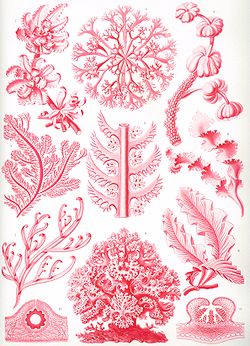| Florideophyceae Temporal range: | |
|---|---|
 | |
| "Florideae" from Ernst Haeckel's Kunstformen der Natur , 1904 | |
| Scientific classification | |
| Domain: | Eukaryota |
| Clade: | Archaeplastida |
| Division: | Rhodophyta |
| Subdivision: | Eurhodophytina |
| Class: | Florideophyceae Cronquist, 1960 [2] |
| Subgroups | |
Florideophyceae is a class of exclusively multicellular red algae. [3] [4] They were once thought to be the only algae to bear pit connections, [5] but these have since been found in the filamentous stage of the Bangiaceae. [6] They were also thought only to exhibit apical growth, but there are genera known to grow by intercalary growth. [6] Most, but not all, genera have three phases to the life cycle. [6] In the subclass Nemaliophycidae there are three orders, Balbianiales, Batrachospermales, and Thoreales, which lives exclusively in freshwater. [7]
